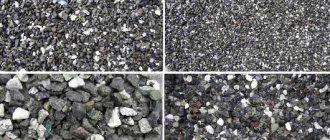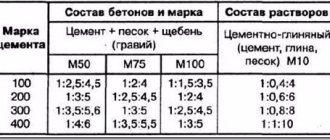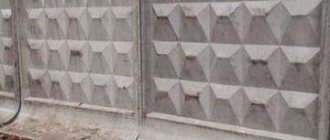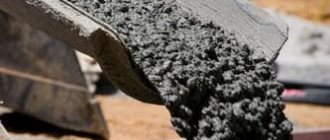Link: Appendix F to SP 70.13330.2012
Relevance: Current form of executive documentation
Changes: as amended on June 27, 2018 (valid to this day)
Scope: for the production and acceptance of concrete work performed during the construction and reconstruction of enterprises, buildings and structures in all sectors of the national economy
Purpose: Inspection of concrete work during construction and installation work at the site
Concrete work is carried out on many construction sites. According to clause 3.5 of SP 70.13330.2012, data on the implementation of concreting must be recorded in the concrete work log . The form of the document is also given here - in Appendix F. The journal is necessary for the proper implementation and subsequent quality control of concreting work.
The document is small, so its design and completion does not take much time. The log should be kept by a responsible manufacturer, for example, a foreman or site foreman during the period when concrete work is being carried out. On our website you can download the concrete work magazine in word, excel and pdf formats. It includes a title page and a tabular section of 14 columns. They are filled in by different people:
- Columns 1 to 8 are completed by the responsible manufacturer.
- Columns 9 to 13 are filled in by the person who tests concrete structures for strength.
- The last column No. 14 is signed.
What is a concrete work log and why is it needed?
The concrete work log is a document for recording and quality control of concrete pouring work. The log reflects all the information about who, when and under what conditions carried out the construction of concrete or reinforced concrete structures, as well as detailed parameters of the concrete used. Its type and structure are strictly defined in a set of rules. The log is a table with 14 columns.
At sites controlled by state supervisory authorities, reinforced concrete products must undergo pre-registration with construction supervision. This must be done 7 working days before the start of work.
Before registration with the supervisory authority, the log must be numbered, stitched with at least 2 holes and sealed with the developer's seal. Each volume has its own title page. The number of pages in the magazine is not regulated. Numbering is done at the bottom of the page so that there is free space on the right. Later it will be used for continuous numbering of the entire package of documents.
Stroynadzor will register the ZhBR under its number and also affix its seal. Only after this can the log be transferred to those directly performing the work at the site.
The Customer is responsible for the timely registration of the ZBR.
The reinforced concrete works are carried out in shifts, and entries are made in it on the days when concrete pouring work is carried out. The log is filled out by a responsible employee whose powers are approved by a separate internal regulatory act or order of the organization. As a rule, this is a master or a work maker.
Care measures
We list the most common measures when curing concrete structures:
- Water leaves primarily through surfaces, so it is necessary to protect them from wind and sun exposure. For this, film or damp cloth or tarpaulin is used. There are also special solutions to protect against drying out. As a last resort, you can fill it with shavings or sawdust, which also need to be moistened with sand. The shelter additionally provides protection of its surface from damage by precipitation (rain, hail).
- If concreting is carried out in the ground, then to protect against the filtration of water from the solution into the soil, it is necessary to provide waterproofing.
- To achieve optimal moisture content, concrete must be constantly moistened (most tips on how to care for concrete after pouring concern only this operation). The best option (this is how the hardening of the test cubes occurs) is to place the structure in water after two to three days. But for large structures this is impossible to implement. Usually, the surfaces are simply shed under low pressure so as not to damage or moisten the material with which they are covered.
Filling out the title page
The first thing you will need to do - even before registering with construction supervision - is to draw up a title page. There is nothing particularly complicated here, all points are clear from the names:
- Journal number.
- The name of the organization that directly carries out concrete work.
- The name of the object, according to the design (working) documentation, as well as the code.
- Address of the object.
- Concrete class based on the compressive strength of structural elements - here you need to indicate the elements to be concreted and the grades of concrete used for each element.
- The volume of concrete in cubic meters - three columns, where the total volume is entered from the working documentation, as well as separately the volume of unreinforced and reinforced concrete. If the actual volume differs, a mark is placed next to it. Example: 52.1 (actual 52.4)
- Work foreman is a responsible employee who conducts reinforced work (Must be assigned by a separate internal order to the responsible persons)
- Start and end dates for logging concrete work.
What regulates the care of concrete after pouring?
At the moment, in the construction industry, these works are regulated by the section “curing and maintaining concrete” SNiP.03.01-87 “Load-bearing and enclosing structures”. It is small, three points, which define that:
- Optimal temperature and humidity conditions and protection from precipitation and moisture loss must be observed (a concrete care log helps control these conditions);
- care of concrete must occur in accordance with the work plan (WPP);
- the strength (1.5 MPa) is determined at which the movement of people and the installation of further tiers of formwork on the surface are allowed.
Conclusion - a correctly developed PPR, which includes the necessary measures, is very important.
An example of filling out a concrete work log according to SP 70.13330.2012 appendix F
Columns 1 to 7 are filled in by the responsible contractor, whose name is written on the title page, directly when laying concrete.
Columns 8 to 13 are filled out by a representative of the construction laboratory based on the results of checking control samples and the concrete structure itself.
Column 14 – signatures of all persons responsible for the quality of the work performed.
Corrections in the journal are allowed only by the hand of the responsible person. If an error needs to be corrected, the incorrect entry is crossed out, and a new one is added next to it, confirming the correction with the signature of the work contractor.
Next, let's look at the points.
Columns 1-7 ZhBR
- The date and time when the concrete is laid is set. Example: "04/06/2008 09:10".
- Must comply with design documentation, including construction axes and altitude.
- This item is filled out according to the concrete mix passport. Also, the organization carrying out construction can be a manufacturer. Example: “Concrete Plant LLC.”
- Not only the class of concrete is recorded here, but also its associated characteristics, such as frost resistance, water resistance and others. This data is in the concrete quality certificate - its number is also written in this column. If there are several quality documents, all are indicated. Example: “BSG V25 P2 F100 W4 / No. 1091.”
- The volume of concrete laid in cubic meters is in the concrete mix passport. Example: "35".
- Air temperature in degrees Celsius. Example: "+7".
- Can be normal (at a temperature of 15-20°C) or with heat treatment at normal pressure. You should also clarify exactly how the heat treatment was carried out, if any. Example: “Thermal treatment infrared heating.”
Columns 8-14
8. It is recorded based on the design documentation. Example: "B25".
9. The actual strength class established during testing. Example: "B25".
10. Concrete of a certain class must gain a certain percentage of strength prescribed by the standard within 7 days. It should be written down here. Example: "70".
11. The actual strength on the seventh day, determined based on test results, is entered. The percentage of actually gained strength over 7 days from the design value. Example: "73".
12. Control samples are taken during pouring and sent to the laboratory. The test result after 7 days is recorded here. Example: "12".
13. Test results are recorded in this column after reaching the design strength - after 28 days. Example: "19.4".
14. The record is sealed with the signatures of all responsible persons (work performer and laboratory assistant).
Columns 8 to 13 can also be filled out by the work manufacturer, but only on the basis of a report provided by the laboratory and certified by the chief engineer. In this case, the laboratory worker’s signature is still required.
Closing the concrete work journal is completed in the same way as other journals: date/signature.
What processes occur during concrete hardening?
During hardening, the water that was used for mixing reacts with the substances that make up the cement. As a result, a durable cement stone is formed. This process is quite lengthy, the material gains brand strength after 28 days, but hardening does not end there; some reactions with sufficient moisture can take much longer.
But since this indicator is taken into account in all calculations, it is important to ensure optimal hardening conditions during this period.
Summary tables of concrete characteristics and composition
Options:
- Concrete class based on compressive strength.
- Average strength of concrete, kgf/cm².
- Strength grade of concrete.
- Frost resistance F.
- Waterproof W.
Measures for winter concreting
It is not advisable to carry out concrete work in the summer, but this does not always work out. Carrying out concreting in cold weather requires the use of special technologies - for example, antifreeze additives are introduced into the mixture to reduce the temperature at which ice crystals form. Caring for concrete in summer differs from such work in winter, when special measures are taken to ensure normal hardening.
Here are examples of caring for poured concrete in winter.
- The formwork is insulated. Open surfaces are not only covered to reduce evaporation and protection from precipitation and sun, but also additionally insulated.
- Structures are heated in several ways - with external electric heaters or heat exchangers, with the help of infrared lamps or burners, or heating is carried out by passing current from special transformers through the reinforcing mesh.
- Only hot water is used for humidification.
- If this is possible, then a shelter or tent is installed around the structure, the internal volume of which is heated using air heat generators (guns) or another method. It is also possible to supply steam, then the surface will be moistened at the same time.
Instruments for determining cement activity
There are various instruments for determining the activity of cement, here are some of them:
- Cement activity indicator IAC-04M. The system will allow you to determine the activity of a sample in 5 minutes. The activity of cement is calculated based on the determined specific conductivity of the W/C solution. The device gives a large error - up to 5% in one direction or another, so it cannot completely replace standard tests. The indicator will allow you to timely detect malfunctions in the operation of cement production equipment, incorrect chemical or mineral composition, and unacceptable storage conditions.
- Cement forecast 2. Allows you to determine the activity of cement in an accelerated mode within 3 hours, measurements are made by finding the value of the cement paste contraction. In normal cases, activity is determined in 1, 3, and 7-day modes.
Cement activity indicators may not give very accurate results, but their use is useful when there is no time for standard laboratory testing.
Which hip replacement is best? Cemented or cementless?
Now, unfortunately, even from many surgeons you can hear that a cemented endoprosthesis is bad, and a cementless one is good. Actually this is not true. Cemented and cementless hip replacements are not the same, and each has its own pros and cons. And if a surgeon says that a cement endoprosthesis is bad, then he is either disingenuous or does not understand endoprostheses at all. Firstly, cemented and cementless hip arthroplasty originated, formed and improved almost separately from each other; cemented arthroplasty predominates in Europe (especially Sweden, Norway, Great Britain), and cementless arthroplasty predominates in the USA. In the last 10-15 years, these endoprosthetics systems have been mixed and cementless endoprosthetics have become increasingly used in Europe, and cemented endoprosthetics in the USA.
For example, in Sweden in 2005, more than 90% of all hip replacements are performed using bone cement, and in 2009 - more than 80%. In the UK, about 70% of endoprostheses installed are now cemented, and only 30% are cementless.
Agree that if cement endoprosthetics are used so often in the UK and Sweden, then most likely it is not so bad, and you shouldn’t scold cement endoprostheses so much and think that they are bad.
How to fill it out?
Many people ask this question, but I think everything here is intuitive and after reading the example of a completed journal, many of your questions have disappeared, but I will still try to explain some points to you.
The magazine consists of a title page and a table of 14 columns. The first 8 columns are filled out by the responsible contractor, and from 9 to 13 are filled out by the one who tests concrete structures for strength. Strength is tested at intermediate and design (28 days) age.
When you fill out column 4, try to indicate all the symbols of concrete. For example, if the project specifies the use of concrete B20F100W6, then indicate all this data in the journal. If you indicate only class B20 concrete in the concrete work log, then during the inspection the inspector of the state construction supervision may doubt the concrete used and demand proof of its compliance with the requirements of frost resistance and water resistance.
And you will have to prove this by presenting a quality document for the concrete mixture, but they may also miss and not write down the data on frost resistance and water resistance. And you will have to do additional technical inspection of concrete structures. Do you need it?
The concrete work journal, like all other journals, must be numbered, laced and secured with the organization’s seal. Also, corrections and blots are not allowed. It is included in the list of as-built documentation and, upon completion of construction, is transferred to the developer, and then to the operating organization.
If concrete work is carried out at an outside temperature of less than +5°C, especially in winter, it will be necessary to keep a concrete maintenance log. We'll talk about him.
Ps If you have any questions, feel free to ask them in the comments, and I will try to answer them. Subscribe to the blog and be the first to receive new articles.
Functions of magazines in construction
Logs are a type of executive documentation, with the help of which the current state of affairs at a construction site, comments from regulatory authorities are monitored, the responsibilities of engineering and technical personnel are clearly stated, deviations from the schedule are recorded, and the like. Types of logs vary depending on the objects and work performed.
The importance of maintaining such documentation is difficult to overestimate. The quality of the material after hardening cannot be checked in any other way except by reading the relevant documentation without destroying the structure. Concrete work is a critical stage of construction.
If during the process of pouring concrete there were violations of building codes and regulations, this can lead to negative consequences.
Other methods
Other compaction methods include:
1) . Mechanical . Builders resort to this method when processing significant volumes of cement. The process is carried out using special devices, which include surface and internal vibration devices. Specialists also use mechanisms that are attached to wooden formwork or a container with a mixture.
In particular, surface vibratory slats allow only the top concrete layer to be compacted. Therefore, builders use it for products made from a thin layer of concrete: bases for tiles, floors, roads, etc. The internal vibrating screed, in turn, is considered the most effective in comparison with other mechanisms. In addition, such devices are easy to operate and are used for processing concrete in hard-to-reach areas.
Vibrators, which are installed on wooden formwork or form, are securely fastened, compacting the mixture due to vibrations of the formwork transmitted to the cement mortar. Formwork devices are indispensable for concreting products of unusual shapes.
2). Vibration compaction. Produced using portable and stationary devices. The use of portable mechanisms for precast concrete structures is limited. They are used to create large and heavy products.
Vibrating platforms are necessary in the production of reinforced concrete in factories operating according to special schemes. The modern market offers a large selection of vibrating platforms, including electromagnetic, pneumatic, combined, etc.
3). Pressing. Experts less often resort to this method of compacting the mixture, although it is considered effective because it allows increasing the strength of the mortar with low cement consumption. This method is not widely used due to its high cost.
The pressure required for pressing concrete should be from 10 MPa. Presses that have similar power are used in the shipbuilding industry to create new ships. However, it should be noted that the cost of such pressing devices does not allow them to be used for private construction work.
During the preparation of cement mortars, pressing should be used only as an additional load during vibration compaction. The required degree of pressure can be no higher than 1 kPa. The modern market offers flat and profile dies. In particular, profile stamps are needed to give the desired texture to a particular product.
This is how concrete panels, flights of stairs and other elements and structures from this material are made. This type of pressing is called stamping. Another type of pressing is rolling. In this case, the pressure on the cement mortar is carried out by the roller. This allows you to reduce energy consumption due to reduced pressure during pressing.
But the method has one drawback related to the properties of the solution. In some cases, the material may be displaced or torn by the roller.
4). Centrifugation. When rotating, the composition is compacted by adhering to the walls of the mold. After centrifugation, the density of the ingredients included in the cement mortar increases. In addition, approximately 30 percent of the water is removed from it. This helps increase the strength of concrete. The method allows you to make durable products.
Centrifugation will require more cement than other types of compaction. The concrete solution will have the required viscosity. Otherwise, under the influence of the centrifuge, the composition will separate. The technology helps make power line supports, racks and pipes.
5). Vacuuming. The method allows you to rarefy the air, so that all excess is removed from the mixture under strong pressure. Accordingly, the density of the mixture increases.
Recommendations
To ensure that the cement composition is evenly compacted, the following recommendations must be followed:
- When installing wooden formwork, you should pay attention to the reliable fixation of parts. There should be no gaps on the structural elements (the concrete solution can be squeezed out through the cracks). It is necessary that the formwork is polished and smooth, otherwise it will leave dents on the product. In addition, voids may subsequently form in the body of the structure.
- Parts of wooden or plywood formwork, including wedges, must be securely fixed to prevent the boards from moving.
- When vibrating the composition, you should periodically change the position of the vibrating screed, otherwise the solution will be inhomogeneous and cavities will form.
- Experts advise not to spend a lot of time on the work, as this can cause delamination, which appears due to the fact that large crushed stone is knocked down at the bottom, and only cement mortar accumulates at the top.
Defects in concrete and reinforced concrete structures due to insufficient compaction of the concrete mixture.
Since the use of surface vibrating devices does not allow visual determination of the degree of density, during construction work an additional means is often used to help ensure the strength of the composition. To do this, builders add a solution with high plasticity to the existing composition. For this reason, the risk of product delamination increases. To avoid such a drawback, it is recommended to increase the amount of cement.
Compaction factor
The quality of a concrete composition can be assessed using one important criterion. We are talking about the compaction coefficient. The coefficient is determined as follows: the ratio of the specific gravity of the finished mixture to the value that was obtained in the absence of air bubbles inside is calculated. Thus, the acceptable value of the coefficient is 1.
This indicator can be achieved using different methods of concrete compaction; the choice of methods will depend directly on the composition, purpose and fractions. Automated vibrating screeds significantly increase the quality of the solution.











